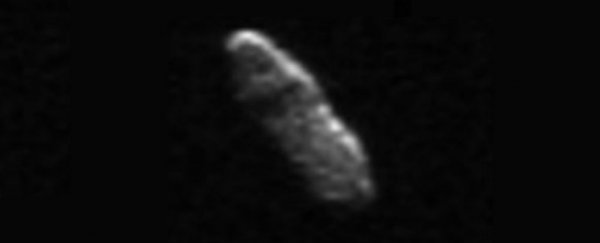Not one to be forgotten in the midst of all our Christmas celebrations, space is giving us plenty of reasons to look up and marvel at its various cosmic phenomena, sending an asteroid our way on 24 December, and then dishing up the first Christmas full moon in almost 40 years.
You don't want to miss out on seeing either of these events - we won't see Asteroid 2003 SD220 around these parts again till 2018, and we have an even longer wait for the Moon and Christmas to line up again. NASA predicts that the next full moon to fall on Christmas Day will not occur until 2034.
At its closest point, Asteroid 2003 SD220 will zoom past Earth about 11 million km (6,787,600 miles) away, which is more than 28 times the distance between Earth and the Moon. While only professional and amateur astronomers will have access to the telescopes needed to spot it, this is no tiny speck in the sky. Astronomers have estimated that the asteroid is around 2 km in length, and it's hurtling through space at around 27 km/second.
NASA advises that we don't have to worry about it impacting Earth for at least the next couple of centuries, so go ahead and celebrate your next 200 Christmases with abandon. You also don't have to worry about reports that Asteroid 2003 SD220 will cause earthquakes as it makes it closest flyby - they couldn't be further from the truth.
"Those assertions are misleading and incorrect. Even if 2003 SD220 were passing closer, it's doubtful earthquakes would result," Eddie Irizarry writes at Earthsky.org. "In fact, there's no scientific evidence that an asteroid's flyby can cause any seismic activity, unless it collides with Earth, but - in this case - that clearly will not be the case."
For those of you without a telescope - Irizarry says even the 8-inch (20-centimetre) telescopes some skywatchers used to view Asteroid 2015 TB145 on Halloween and Asteroid 2004 BL86 back in January won't be enough - Christmas Day is your time.
A full moon will cooincide with 25 December for the first time since 1977, and the same event won't occur again till 2034. It will also be the last full moon of 2015.
All of which is more than enough reason to wake up early and catch a glimpse of it in its silvery glory - NASA predicts its peak will occur at 6:11am EST. That's 10am for us in Australia, which gives us plenty of time to dust off the cookie crumbs and trundle our pudding-laden bodies outside for a look.
"As we look at the Moon on such an occasion, it's worth remembering that the Moon is more than just a celestial neighbour," says John Keller from NASA's Goddard Space Flight Centre. "The geologic history of the Moon and Earth are intimately tied together such that Earth would be a dramatically different planet without the Moon."
'Tis the season to stop taking the Moon for granted, you bunch of ingrates! Only kidding, but seriously, don't forget about the Moon this Christmas. It's about to become a second home to our astronauts, so give it a salute between eggnogs, okay?
